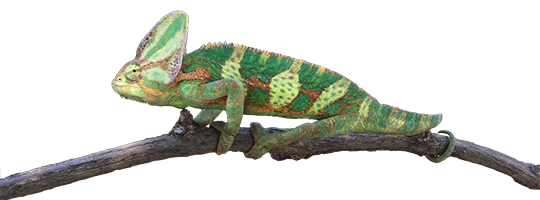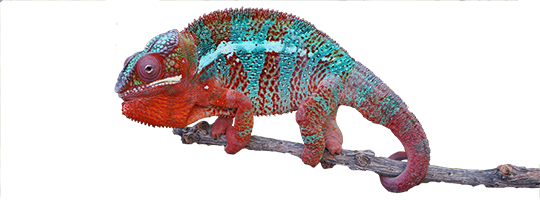Summary: Choosing Your Chameleon
- A captive hatched/born baby is always best. Avoid wild caught
- Male and female are equal in pet potential
- A healthy female chameleon can lay eggs without an issue
- Buying from a breeder allows expert support
- Veiled Chameleons: Very hardy; often “cranky” personality
- Panther Chameleons: The most “mentor” supported species of chameleon
- Jackson’s Chameleons: Generally mild tempered; require nighttime temperature drop
- One chameleon per cage. Do not keep chameleons together!
- Do NOT keep Jackson’s Chameleons together! -Just to be perfectly clear-
You have two multi-media options to research the topic of choosing your first chameleon. The first is a podcast episode that you are able to listen to and the second is a video to watch. Of course, the text summaries continue below!
Captive bred vs. Wild Caught

The best way to start with chameleons is to get a captive bred baby. Wild caught chameleons are attractive due to their age and the lower price. But require acclimation and often veterinary attention. The #1 best way to start with chameleons is with a healthy chameleon. A captive bred baby is that way.
Captive bred babies also have the benefit that there was a breeder with whom you can rely on for help.
And please do not make a decision based on the price tag. Captive bred chameleons will be more expensive. It takes at least a year and a half to ensure healthy parents, incubate eggs, and raise the babies up to sellable age. So, yes, there are expenses behind captive bred. But they are in prime condition all the way back to their parents before they existed. The cheaper price tag of the wild caught chameleons also comes with acclimation challenges and veterinary costs. The three things you need to invest money – and do not cut corners – in are the initial quality of the animal you are buying, your lighting system which includes the UVB bulb, and your supplementation.
Conclusion: Buy a captive hatched/born chameleon from a reputable breeder
Male Vs. Female

Females are often considered less pet quality than males because they lay clutches of eggs, even infertile clutches, and the care plus nutrition that goes along with that. There is a kernel of truth to that. But female chameleons are designed to lay eggs and if you give them the proper conditions 1) they are much less likely to lay an infertile clutch and 2) if they do lay one, they will lay it and bounce back just fine. The thing is that they can be healthy chameleons only if they are given the correct husbandry. This means the proper temperatures, nutrition, and hydration. This is true for males as well! I would much rather hammer in proper husbandry than to suggest getting a male because they can handle more improper care. A properly cared for female has no issue going through the natural processes.
If you have fallen in love with that one chameleon at the pet store and she happens to be female, rest assured that, if you are diligent in providing proper husbandry, she can have a long life with you. You only need to give the nutritional requirements and an appropriate egg laying area if she cycles. That said, if you are selecting a chameleon and can choose either male or female, I would suggest selecting a male because of the decreased complexity in care.
Conclusion: Under proper husbandry conditions, both male and female chameleons will be fine pets. Though a male chameleon will avoid learning about egg production support while you are learning basic chameleon care.
Species Requirements Dictate Cage Type

As many chameleon species are comfortable at the temperature and humidity range that human houses are kept at, screen cages are popular for chameleons. But if you selected species has different requirements than you home provides then a PVC sided or even glass terrarium is appropriate as the PVC sided cages give more control over humidity and the glass terrarium gives more control of both humidity and temperature.
This is important as you select the type of chameleon you will get. Success will be easier the closer your environmental conditions match what your chameleon needs. There are cool, humid weather chameleons and hot, dry weather chameleons. It will take research, no doubt, to find the proper species and determine if they are available, but it is well worth pairing your conditions with their needs.
The closer your conditions match your chameleon’s needs the more a screen cage is appropriate. The further your conditions from your chameleon’s needs the more solid sides are needed to control the environment inside the cage. There is an entire module on cage selection so we will dive deep into this subject. For now, consider environmental conditions when selecting a chameleon species.
Veiled Chameleon (Chamaeleo calyptratus)
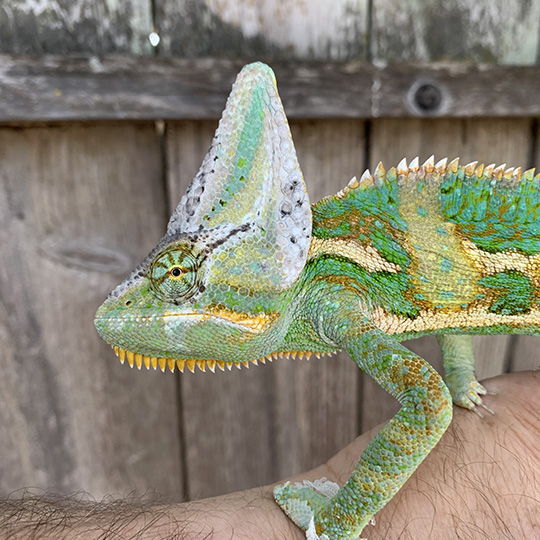
The Veiled Chameleon is a spirited chameleon. Often it is described as cranky or shy. Occasionally, veiled chameleons can be friendly. But expecting this will usually lead to disappointment.
Veiled Chameleons are enthusiastic eaters due to their genetic sense of urgency to grow up, mate, and lay the eggs of the next generation before the dry season comes and removes all their food. This is a delight to us humans who love to watch chameleons eat, but we must severely back off when they become adults or else health problems can occur, especially for females. And it is no surprise that their rapid growth accelerates the onset of Metabolic Bone Disease if proper calcium and UVB or Vitamin D3 is not offered.
Female Veiled Chameleons have a bad reputation for dying egg bound. This is entirely due to improper husbandry. A healthy female veiled chameleon will be able to pass any clutch without issue. Although they are genetically programmed to eat everything they can catch, our ability to feed them bypasses their ability to process food in a healthy manner and they get fat. This is deadly for the female as the over supply of food causes her body to over produce eggs and develop fat pads that impede the laying of eggs.
Both sexes of the Veiled Chameleons will need at least a 2’ x 2’ x 4’ tall cage as adults.
Veiled Chameleons do well in environmental conditions that humans enjoy. Ambient temperatures can be upper 70s to low 80s during the day and low 70s or below at night. Target a basking spot in the mid 80s F.
Click the Veiled Chameleon below if you would like more in depth information on this species.
Panther Chameleon (Furcifer pardalis)

Panther Chameleons tend to have mild personalities, but it is not uncommon to encounter one that is unafraid to let you know you are not welcome in his (or her) domain. Panther Chameleons are very intelligent and will easily memorize a consistent feeding schedule. Chameleons know their people and Panther Chameleons, especially, excel at this.
Panther Chameleons are native to Madagascar and are widespread. Each area has a much different and wildly colored variation. This chameleon is the community’s greatest breeding success as far as establishing a species with many breeders involved and multiple captive generations.
A major advantage of Panther Chameleons is the ease by which you can find successful and knowledgeable breeders that can guide you along.
The minimum cage size is the standard 24” x 24” x 48” or like dimensions for males. I would encourage the same for females, though a single female can live in a 18” x 18” x 36” cage.
Ambient temperatures range from upper 70s to low 80s during the day and low 70s or below at night. A basking spot in the mid 80s is sufficient.
The Panther Chameleon is a drop dead gorgeous creature, widely available as captive bred, and has a huge network of breeder support.
Click the Panther Chameleon below if you would like more in depth information on this species.
Jackson's Chameleon (Trioceros jacksonii)
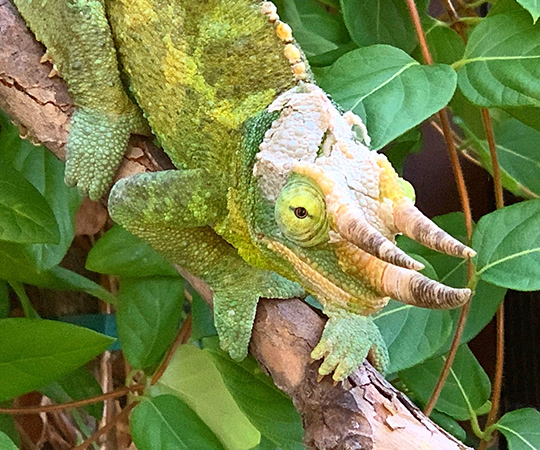
The Jackson’s Chameleon usually seen in the pet trade is the Yellow-crested Jackson’s Chameleon which is the largest of three subspecies. Occasionally, a smaller and more colorful subspecies, the Machakos Hills Jackson’s Chameleon is available. Care for both is identical. Their personality is mild to the point where it is to their detriment. The Jackson’s Chameleon is the chameleon species most kept together as a pair due to the keeper’s inexperience in noticing the subtle clues of stress.
The one environmental condition that is the most challenging is that this species requires significant night time drops. Jackson’s Chameleons are from a higher elevation than the others we have looked at. They experience, and have grown dependent on, significant night time drops. Without these their body slowly loses vitality and they can suddenly go into a quick decline in health.
Jackson’s Chameleons enjoy ambient temperatures in the mid 70s. They start to be stressed when temperatures get into the 80s. Basking temperatures in the mid 80s have been shown effective. But this must be something they are able to get into to warm up and then retreat out of when they are happy with their body temperature. At least a 10 degree drop at night appears to be a requirement for their bodies. If you cannot provide the night time drop or mild daytime temperatures you are encouraged to consider other species.
Both sexes of Jackson’s Chameleons need at least 24” x 24” x 48” or like dimensions. This same size is recommended for the Machakos Hills subspecies as well.
Click the Jackson’s Chameleon below if you would like more in depth information on this species.
Dwarf, Carpet, and Lesser Chameleons: The Smaller Chameleon Species to Consider
There are hundreds of species of chameleon from ones that are able to perch on the tip of your finger to ones that will take up your entire forearm. There are a number of very nice “finger-sized” chameleons that will be able to be housed in smaller cages or be able to stretch even further in a large cage. Luckily, these species are usually available as captive bred. Carpet Chameleons used to be available as wild caught and those individuals did not fare so well as a whole. But the captive hatched babies that are available now are strong and provide a great chameleon experience.
You are more likely to see these smaller species, especially Furcifer lateralis and F. minor, being kept in naturalistic solid side cages where they do very well. Although it is not necessary to keep them like this it is an experience that is enjoyable and adds another dimension to the chameleon keeping experience.
| Common Name | Scientific Name | Care is similar to |
| Carpet Chameleon | Furcifer lateralis | Panther Chameleon |
| Natal Midlands Dwarf Chameleon | Bradypodion thamnobates | Jackson's Chameleon |
| Lesser Chameleon | Furcifer minor | Panther Chameleon |

A Female Carpet Chameleon (Furcifer lateralis)

A male Natal Midlands Dwarf Chameleon (Bradypodion thamnobates)

A Male Lesser Chameleon (Fucifer minor)
Parson's and Meller's Chameleons: The Giant Chameleons
We have entered into an exciting period in the community where captive bred Parson’s and Meller’s Chameleons are available. These chameleons are no more difficult to take care of than other chameleons other than the space they need to live. These chameleons are impressive, but make sure you have the space necessary to keep them happy. Many people have these chameleons as their dream chameleon and they will certainly not disappoint! They are amazing! So, are they suitable as a first chameleon? That depends on you. Cost aside, if you are willing to do the research into their conditions and dedicate the space and money/time resources that is required then you do not need to graduate to them. In fact, if your heart is set on one of these species then it is not fair to that Veiled Chameleon for you to consider it a “practice chameleon”. If your heart is not set on one of these larger species I would suggest starting with a species that is, space-wise, easier to take care of.

A male Yellow-lipped Parson’s Chameleon (Calumma parsonii parsonii)
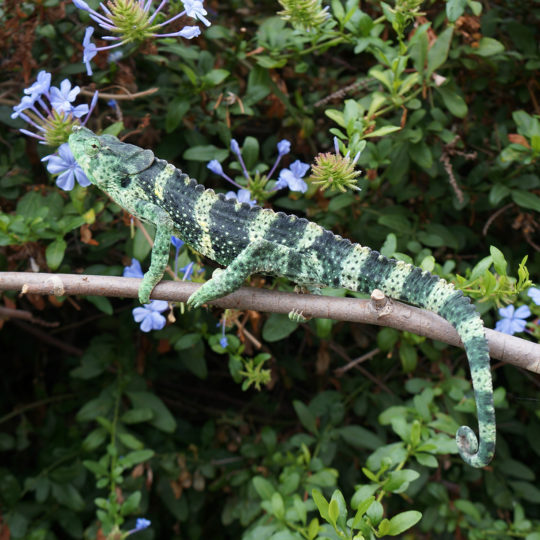
A Meller’s Chameleon (Trioceros melleri)
Choosing a Species Wisely
When choosing a species, personal preference and appeal is important, but to truly have a positive experience you want to choose a species that will do well in the environmental conditions you have available. Adding heat to an environment is a lot easier than making things colder. So a cool climate would be much more successful keeping a Veiled or Panther Chameleon than a hot climate would be keeping a Jackson’s Chameleon and their need for a nighttime temperature drop.
Choose a species that fits the area that you have available for a cage. A huge Parson’s Chameleon would be cramped in some of the standard cages that a carpet chameleon would consider a mansion. If you are limited on space, select a smaller species of chameleon.
Use the files here in the academy to learn more about each species and what they are like in captivity. Make an educated choice and put the odds in your favor for having a great chameleon experience!

So...what is the best chameleon to get?
You read the pages and have done the analysis and still are not sure. And that is okay. There is a lot to take in! If I were to pick the best chameleon to start with I would say a captive bred male Panther Chameleon from a reputable breeder.
Panther Chameleons have unreal colors and will be a delight to watch grow up. They are widely available as captive bred specimens from experienced breeders. Although Veiled Chameleons may be more available as captive bred, they are often not being bred by experienced breeders. This is important because it is the experienced breeders that will make sure the adults have had a healthy life before your baby was ever made and they will offer experienced support of you while you get set up and have to ask questions you didn’t to think to ask before something happened. Everything from the panic a beginner feels upon witnessing their first shed to serious problems like your chameleon “napping” during the day are able to be answered by an experienced breeder.
Panther Chameleons have great personalities (for a chameleon) and are intelligent (for a chameleon). So, for their hardiness, appeal, availability as captive bred, and wide backend support, I choose the Panther Chameleon as the best first chameleon.
So now the hard part…choosing a color morph!

Navigation
Choosing Your Chameleon is a class that is part of the Term 1: Getting Started With Chameleons coursework which gives you a basic exposure to the important issues in chameleon husbandry. You don’t have to have made your final choice on chameleon to go on, though, because there is much to cover and prepare for before your chameleon comes home with you! Take the next step in your chameleon journey by selecting the right chameleon cage in the next, appropriately named course: Selecting a Chameleon Cage!


